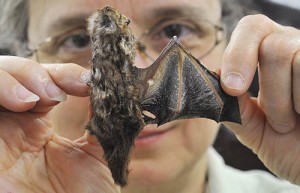Bats, Bugs, Wind Turbines, and Unintended Consequences
-
Scott Detrow
Correction: an earlier version of this post claimed produce becomes more expensive when bugs aren’t eating it. We meant to say produce becomes more expensive when more BUGS are eating it. We regret the error.
Bats eat bugs. Bugs eat produce.
The more bugs that eat produce, the mores expensive it becomes. And bats that die in wind turbines certainly aren’t in any position to eat bugs.
The Post-Gazette’s Erich Schwartzel had a great story in Sunday’s paper, looking at the thousands of bats eaten up by Pennsylvania’s growing number of wind turbines each year, and the surprising trickle-down effect the phenomenon is causing:
The 420 wind turbines now in use across Pennsylvania killed more than 10,000 bats last year — mostly in the late summer months, according to the state Game Commission. That’s an average of 25 bats per turbine per year, and the Nature Conservancy predicts as many as 2,900 turbines will be set up across the state by 2030
.…
Bats are nature’s pesticide, consuming as many as 500 insects in one hour, or nearly 3,000 insects in one night, said Miguel Saviroff, the agricultural financial manager at the Penn State Cooperative Extension in Somerset County.
“A colony of just 100 little brown bats may consume a quarter of a million mosquitoes and other small insects in a night,” he said. “That benefits neighbors and reduces the insect problem with crops.”
If one turbine kills 25 bats in a year, that means one turbine accounted for about 17 million uneaten bugs in 2010.
According to a study quoted in the article, bats save farmers about $74 an acre. That’s $22 million to Lancaster County, $15.2 million to Berks, and more than $2 million in Bucks County.

















